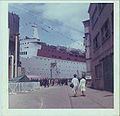
SS France was a Compagnie Générale Transatlantique ocean liner, constructed by the Chantiers de l'Atlantique shipyard at Saint-Nazaire, France, and put into service in February 1962. At the time of her construction in 1960, the 316 m (1,037 ft) vessel was the longest passenger ship ever built, a record that remained unchallenged until the construction of the 345 m (1,132 ft) RMS Queen Mary 2 in 2004.

Swedish American Line was a Swedish passenger shipping line. It was founded in December 1914 under the name Rederiaktiebolaget Sverige-Nordamerika and began ocean liner service from Gothenburg to New York in 1915. In 1925 the company changed its name to Svenska Amerika Linien / Swedish American Line.

Zim Integrated Shipping Services Ltd., commonly known as ZIM, is a publicly held Israeli international cargo shipping company, and one of the top 20 global carriers. The company's headquarters are in Haifa, Israel; Originating in 1945, ZIM has traded on the New York Stock Exchange since 2021. From 1948 to 2004, it traded as ZIM Israel Navigation Company.

SS Southern Cross was an ocean liner built in 1955 by Harland & Wolff, Belfast, Northern Ireland for the United Kingdom-based Shaw, Savill & Albion Line for Europe—Australia service. In 1975 she was rebuilt as a cruise ship and subsequently sailed under the names Calypso, Azure Seas and OceanBreeze until 2003 when she was sold for scrap to Ahmed Muztaba Steel Industries, Chittagong, Bangladesh.
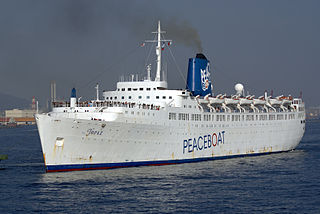
RMS Empress of Britain was a transatlantic ocean liner built by Fairfield Shipbuilding at Govan on the Clyde in Scotland in 1955-1956 for Canadian Pacific Steamships (CP). This ship — the third of three CP vessels to be named Empress of Britain — regularly traversed the trans-Atlantic route between Canada and Europe until 1964, completing 123 voyages under the Canadian Pacific flag.

SS Michelangelo was an Italian ocean liner built in 1965 for Italian Line by Ansaldo Shipyards, Genoa. She was one of the last ships to be built primarily for liner service across the North Atlantic. Her sister ship was the SS Raffaello.

SS Raffaello was an Italian ocean liner built in the early 1960s for Italian Line by the Cantieri Riuniti dell'Adriatico, Trieste. It was one of the last ships to be built primarily for liner service across the North Atlantic. Her sister ship was SS Michelangelo.

SS The Emerald was a cruise ship owned by Louis Cruise Lines. She was built in 1958 by the Newport News Shipbuilding and Drydock company in Newport News, Virginia, United States, for the Grace Line, as the ocean liner Santa Rosa. Between 1992 and 1995, she sailed for Regency Cruises as Regent Rainbow and between 1997 and 2008, she sailed for Thomson Cruises as The Emerald. Before retiring in 2009, she was the last passenger ship built at a U.S. shipyard that was still in active service.

RMS Sylvania was an ocean liner built in 1957 by John Brown & Co (Clydebank), in Glasgow, for the United Kingdom-based shipping company Cunard Line. She was the last Cunard Line vessel built specifically for transatlantic crossings. The ship was later heavily rebuilt as a cruise ship, and sailed under the names SS Fairwind, SS Sitmar Fairwind, SS Dawn Princess and SS Albatros before being scrapped in 2004. She was renamed SS Genoa for her last voyage.
Home Lines was an Italian passenger shipping company that operated both ocean liners and cruise ships. The company was founded in 1946, and it ceased operations in 1988 when merged into Holland America Line. Although based in Genoa, Home Lines was an international company with ships registered in Panama, while the original company chairman Eugen Eugenides was Greek. By the time Home Lines was merged into Holland America, they were one of the most highly regarded cruise lines in the world.

TS Maxim Gorkiy was, until 30 November 2008, a cruise ship owned by Sovcomflot, Russia, under long-term charter to Phoenix Reisen, Germany. She was built in 1969 by Howaldtswerke-Deutsche Werft, Hamburg, West Germany for the German Atlantic Line as TS Hamburg. In late 1973 she was very briefly renamed TS Hanseatic. The following year she was sold to the Black Sea Shipping Company, Soviet Union and received the name Maksim Gorkiy in honour of the writer Maxim Gorky, renamed to Maxim Gorkiy after the collapse of the Soviet Union in 1991. On 20 August 2008 Maxim Gorkiy was sold to Orient Lines. She was due to enter service with her new owners on 15 April 2009 under the name TS Marco Polo II, but in November 2008 the relaunch of the Orient Lines brand was cancelled. On 8 January 2009 the ship was sold for scrap, and she was beached at Alang, India on 26 February 2009.
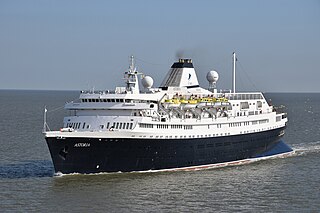
MV Astoria is a ship that was constructed as the transatlantic ocean liner Stockholm for Swedish American Line, and rebuilt as a cruise ship in 1993. Ordered in 1944, and commenced service in 1948, at 76 years old, she is the oldest deep water passenger liner still around in a non retired status. As Stockholm, she was best known for an accidental collision with Andrea Doria in July 1956, resulting in the sinking of the latter ship and 46 fatalities off the coast of Nantucket, Massachusetts, United States.
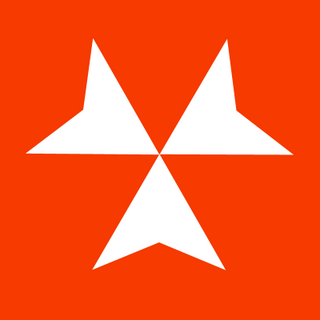
Hamburg Atlantic Line was an ocean liner and cruise ship operating company established in Hamburg, West Germany in 1958 by Axel Bitsch Christensen and Vernicos Eugenides, the latter being the adopted son of Home Lines' founder Eugen Eugenides. In 1966, the company changed its name to German Atlantic Line. Liner services were abandoned in 1969, after which the company's ships concentrated solely on cruising. Due to the 1973 oil crisis, German Atlantic Line closed down in December 1973.
Several vessels have been named SS Doric. You may be looking for:

RMS Empress of Canada was an ocean liner launched in 1960 and completed the following year by Vickers-Armstrongs of Walker, Newcastle upon Tyne, England for Canadian Pacific Steamships Ltd. This ship, the third CP vessel to be named Empress of Canada, regularly traversed the transatlantic route between Liverpool and Canada for the next decade. Although Canadian Pacific Railways was incorporated in Canada, the Atlantic liners were owned and operated by the British registered subsidiary Canadian Pacific Steamships Ltd. and were always British flagged and manned and therefore Empress of Canada was not the flagship of the Canadian Merchant Marine.
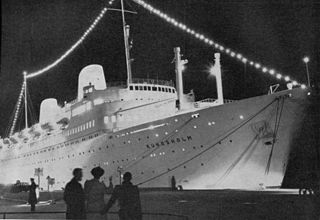
MS Kungsholm was a combined ocean liner / cruise ship built in 1953 by the De Schelde shipyard in Vlissingen, the Netherlands for the Swedish American Line. Between 1965 and 1981 she sailed for the North German Lloyd and their successor Hapag-Lloyd as MS Europa. From 1981 until 1984 she sailed for Costa Cruises as MS Columbus C. She sank in the port of Cadiz, Spain after ramming a breakwater on 29 July 1984. The vessel was refloated later that year, but sent to a Barcelona shipbreaker in 1985 for scrapping.

MS Golden Princess was a casino cruise ship owned by Eurasia International, operated on short casino cruises out of Hong Kong. She was built in 1967 by the Wärtsilä Hietalahti shipyard in Helsinki, Finland as Finlandia for the Finland Steamship Company. In 1975 she was sold to Finnlines, who converted her into the cruise ship Finnstar in 1978. In 1982 she entered service for Pearl Cruises as Pearl of Scandinavia. In 1988 she was renamed Ocean Pearl. In 1994 she entered service with Croisières Paquet as Pearl. Between 1995 and 1998 she sailed for Costa Cruises as Costa Playa. In 1998-1999 she sailed as Oriental Pearl for Mega Wave International, and in 1999-2000 as Joy Wave for Costa Cruises. In 2000 she was sold to Eurasia International and entered service under the name Golden Princess. In 2009 she was sold for scrap to China.

SS Stella Solaris was an ocean liner built for Messageries Maritimes in 1953. She mainly provided passenger service between France, the Middle East, Southeast Asia, and Japan.
For other ships with the same name, see SS Santa Paula.

SS Atlantic was an American-built vessel that operated for 42 years in various capacities. First designated SS Badger Mariner, she was originally built as a freighter in 1953. However, her career as a cargo vessel was relatively short. In 1958, she was rebuilt as a passenger liner. Renamed SS Atlantic, this ship became familiar to many American tourists during the 1960s, making cruises to the Caribbean and Mediterranean.








